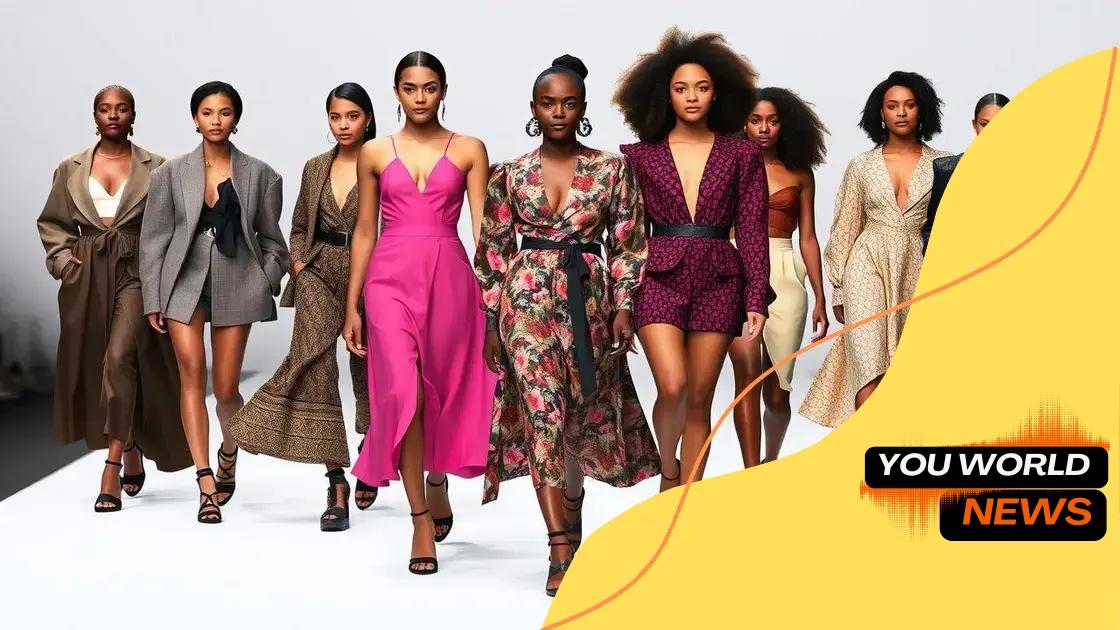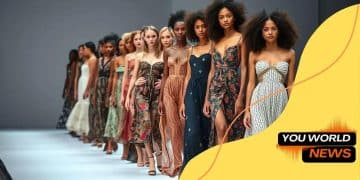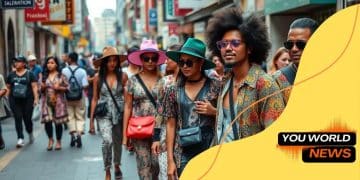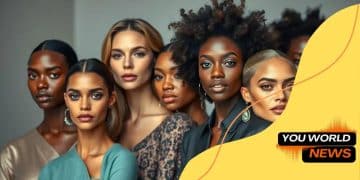How cultural diversity enriches fashion modeling

Diversity in fashion modeling enriches the industry by showcasing a broader representation of beauty, challenging stereotypes, and inspiring future generations while facing challenges related to access and industry standards.
How cultural diversity enriches fashion modeling is an intriguing topic that highlights the vibrant intersection of creativity and culture. Ever wondered how different backgrounds influence what we see on the runway? Let’s dive in and explore.
The importance of cultural representation in fashion
The importance of cultural representation in fashion cannot be underestimated. It’s about more than just variety; it’s about connection, authenticity, and solidarity within the fashion world. Including diverse cultures in modeling leads to a richer tapestry of ideas and creativity in fashion.
The Role of Representation
When designers feature models from various backgrounds, they showcase a broader spectrum of beauty. This representation can challenge stereotypes and inspire individuals from all walks of life. It sends a message that beauty is found in diversity.
Benefits of Cultural Representation
- Inspiration: Diverse models bring unique styles that can inspire trends.
- Relatability: Consumers feel more connected to brands that reflect their own cultures.
- Empowerment: Representation empowers underrepresented communities and fosters inclusion.
- Market Growth: Embracing cultural diversity can expand a brand’s market reach.
In addition to inspiring trends, cultural representation can also support artists and designers from diverse backgrounds. These creators often have stories that resonate deeply, reflecting their heritage and experiences. When the fashion industry embraces this representation, it creates a platform for these voices.
Moreover, showcasing cultural diversity in fashion can improve social awareness. As models from different ethnic backgrounds take the stage, they raise awareness about various cultures and challenges facing those communities. This notion is particularly crucial in today’s globalized world.
Brands that prioritize cultural representation often find themselves leading discussions about ethics, sustainability, and societal impact. These discussions can provide a solid foundation for other brands to follow, ultimately fostering a more inclusive environment.
Overall, the importance of cultural representation in fashion is about creating a space where everyone can see themselves reflected. It’s about unity in diversity, allowing different voices to be heard while encouraging the industry to grow and evolve.
How diversity influences modeling trends
How diversity influences modeling trends is a fascinating topic as it explores the shifting landscape of fashion influenced by various cultures and perspectives. As the fashion industry evolves, models from diverse backgrounds play a crucial role in shaping new trends.
Diverse Perspectives in Fashion
Bringing models from varied backgrounds allows the fashion scene to reflect a wider range of ideas. Their unique styles and cultural influences often lead to innovative designs that resonate with broader audiences. These new trends often challenge traditional norms, promoting inclusivity.
The Impact on Runway Shows
Fashion shows are now platforms where cultural diversity shines. Runway events that feature diverse models attract attention and celebrate individuality. This inclusion often creates a buzz in the media, leading to discussions about representation and beauty standards.
- Creating New Aesthetics: Different cultural backgrounds introduce fresh aesthetics that enrich modeling.
- Breaking Stereotypes: Diversity helps in breaking stereotypes about beauty, making fashion accessible to everyone.
- Expanding Audience Reach: Shows featuring diverse models can appeal to a wider audience, bringing in various demographics.
- Inspiring Future Designers: Young designers are more inspired to create inclusive collections that reflect the world around them.
As the industry embraces diversity, we see a rise in collaborations between brands and models from various ethnicities. These partnerships often lead to campaigns that reflect the richness of different cultures, enhancing visibility and appreciation.
The influence of diversity can also be seen on social media, where various cultures share their experiences and styles. This grassroots movement allows for unique expressions that challenge outdated beauty standards. As consumers, we find ourselves drawn to brands that celebrate this diversity.
The interplay between cultural diversity and modeling trends is reciprocal. Models bring their backgrounds to the forefront, while the trends created showcase this diversity, making the industry more relatable and vibrant.
Real-life examples of diverse models

Real-life examples of diverse models are essential in highlighting the beauty and uniqueness that different backgrounds bring to the fashion industry. These models not only represent their cultures but also inspire others to embrace their identities.
Notable Figures in Fashion
One great example is Adwoa Aboah, a model of Ghanaian descent who has become a voice for mental health and body positivity. Her work emphasizes the importance of authentic representation in modeling. Another inspiring figure is Halima Aden, who is known for breaking barriers by being the first model to wear a hijab on the runway at major fashion events.
The Impact of Diversity
- Inspiring Change: Models like Bella Hadid, who proudly supports her Palestinian heritage, encourages young people to embrace their backgrounds.
- Role Models: Duckie Thot, originally from South Sudan, has made waves in the industry, showing that diversity can redefine beauty standards.
- Brand Collaborations: Many brands now collaborate with diverse models to showcase inclusivity in their campaigns, making their products more relatable.
- Cultural Exchange: These models bring their unique stories, enriching the fashion narrative and encouraging cultural exchange.
Furthermore, models like Winnie Harlow, who has vitiligo, challenge conventional beauty norms. By embracing her skin condition, she inspires others to embrace their differences. Similarly, Ashley Graham has become a leading figure in promoting body diversity, proving that beauty comes in all shapes and sizes.
These real-life examples of diverse models shape the fashion landscape by inspiring change, promoting acceptance, and encouraging brands to be more inclusive. Individual stories create powerful narratives that resonate with audiences, showing that fashion can be a form of expression and healing.
The impact of globalization on fashion diversity
The impact of globalization on fashion diversity has been profound, bringing numerous cultures together in a rich tapestry of styles. As the world becomes more interconnected, fashion thrives on the exchange of ideas and influences.
Bridging Cultures
Globalization allows designers and models from various countries to collaborate. This interaction leads to the creation of mixed styles that celebrate both local traditions and contemporary trends. Designs inspired by different cultures often tell stories that transcend borders.
The Rise of Global Brands
- Increased Accessibility: Global brands often incorporate diverse inspirations, making fashion more accessible to a wider audience.
- Cultural Exchange: The rise of international fashion shows allows for a constant exchange of cultural concepts.
- Marketing Opportunities: Brands that embrace diversity can appeal to diverse customer bases, enhancing their market reach.
- Ethical Collaboration: Working with artisans from various cultures brings authenticity and supports local economies.
Moreover, globalization has led to the recognition of cultural icons and models from around the world. This visibility has opened doors for numerous talents who represent diverse backgrounds, bringing their heritage into the spotlight. For instance, models like Liya Kebede and Maria Borges have emerged as influential figures, showcasing African beauty on global platforms.
The fusion of styles has given rise to unique fashion trends that reflect global influences. For example, the incorporation of traditional prints and patterns into modern designs is now commonplace. These trends celebrate the beauty found in diversity and encourage more inclusive representation in the industry.
As fashion continues to evolve under the influence of globalization, the importance of cultural sensitivity becomes vital. Brands must navigate this landscape thoughtfully to avoid cultural appropriation and ensure respectful representation.
Challenges faced in promoting diversity in modeling
Challenges faced in promoting diversity in modeling are significant hurdles that the fashion industry must overcome. Despite progress, there are still many obstacles that prevent full representation.
Industry Standards and Expectations
One major challenge is the prevailing industry standards, which often favor a narrow definition of beauty. These standards can marginalize diverse models, making it difficult for them to find opportunities. This can create an environment where only a select few are seen as marketable.
Commercial Viability
- Brands’ Hesitation: Many brands still hesitate to cast diverse models due to fears about market reach and sales.
- Consumer Perceptions: Some consumers maintain outdated notions of beauty, which can pressure brands to conform to traditional standards.
- Limited Size Representation: Inclusive sizing is often overlooked, with many brands focusing only on straight sizes.
- Access to Opportunities: Diverse models may face barriers in gaining access to auditions and castings compared to their counterparts.
Moreover, the lack of representation behind the scenes contributes to these challenges. When decision-makers in the industry do not reflect diverse backgrounds, it can limit the perspectives and ideas that influence casting and marketing strategies. This lack of diversity can lead to a misunderstanding of cultural significance and trends, further perpetuating the issue.
Additionally, social media plays a dual role in promoting diversity and exposing its challenges. While platforms can amplify diverse voices, they can also generate backlash against brands that do not meet evolving standards of inclusivity. This tension can create a daunting environment for both models and brands.
As the industry strives for change, addressing these challenges must remain a priority. This involves educating stakeholders about the value of diversity and developing inclusive strategies that resonate with a wider audience.
FAQ – Frequently Asked Questions about Diversity in Fashion Modeling
Why is diversity important in fashion modeling?
Diversity is crucial in fashion modeling because it showcases a broader representation of beauty, allowing different cultures and backgrounds to be seen and celebrated.
What are the challenges faced in promoting diversity in modeling?
Challenges include industry standards that favor a narrow definition of beauty, hesitance from brands to cast diverse models, and barriers in access to opportunities.
How does globalization impact fashion diversity?
Globalization promotes cultural exchange and collaboration, leading to new fashion trends that reflect diverse influences from around the world.
Can diverse models inspire future generations?
Absolutely! Diverse models serve as role models, encouraging young people to embrace their identities and pursue careers in the fashion industry.





